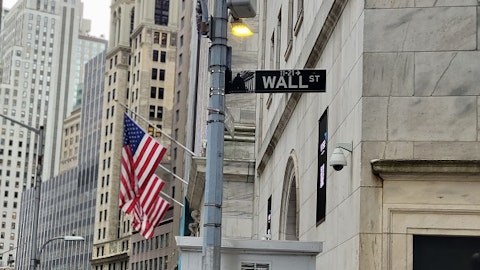BrightSpire Capital, Inc. (NYSE:BRSP) Q1 2024 Earnings Call Transcript May 1, 2024
BrightSpire Capital, Inc. misses on earnings expectations. Reported EPS is $-0.44848 EPS, expectations were $0.24. BRSP isn’t one of the 30 most popular stocks among hedge funds at the end of the third quarter (see the details here).
Operator: Greetings, and welcome to the BrightSpire Capital Inc.’s First Quarter 2024 Earnings Call. At this time, all participants are in a listen-only mode. A question-and-answer session will follow the formal presentation [Operator Instructions]. As a reminder, this conference is being recorded. It is now my pleasure to introduce to you David Palame, General Counsel. Thank you, David. You may begin.
David Palame: Good morning. And welcome to BrightSpire Capital’s first quarter 2024 earnings conference call. We will refer to BrightSpire Capital as BrightSpire, BRSP, or the company throughout this call. Speaking on the call today are the company’s Chief Executive Officer, Mike Mazzei, President and Chief Operating Officer, Andy Witt; and Chief Financial Officer, Frank Saracino. Before I hand the call over, please note that on this call, certain information presented contains forward-looking statements. These statements, which are based on management’s current expectations, are subject to risks, uncertainties and assumptions. Potential risks and uncertainties could cause the company’s business and financial results to differ materially.

For a discussion of risks that could affect results, please see the Risk Factors section of our most recent 10-K and other risk factors and forward-looking statements in the company’s current and periodic reports filed with the SEC from time-to-time. All information discussed on this call is as of today, May 1, 2024 and the company does not intend and undertakes no duty to update for future events or circumstances. In addition, certain financial information presented on this call represents non-GAAP financial measures. The company’s earnings release and supplemental presentation, which was released this morning and is available on the company’s Web site, presents reconciliations to the appropriate GAAP measures and an explanation of why the company believes such non-GAAP financial measures are useful to investors.
Finally, during this call, management may refer to distributable earnings as DE. With that, I would now like to turn the call over to Mike.
Mike Mazzei: Thank you, David. Welcome to our first quarter 2024 earnings call, and thank you for joining us this morning. In my remarks today, I will focus on some key financial highlights for the company, briefly discuss market conditions and provide visibility as to what is ahead. Then I will turn the call over to Andy for more specifics on the portfolio. Starting off with some financial highlights. For the first quarter, we reported GAAP net loss of $57.1 million or $0.45 a share, positive DE of [$22.5] million or $0.17 per share and adjusted DE of $29.7 million or $0.23 per share. Our current liquidity stands at $323 million, of which $158 million is cash on hand. This quarter, we recorded a $0.68 reduction in undepreciated book value, which currently stands at $10.67.
See also 15 Friendliest Countries in Africa and 10 Best Long Term Low Risk Stocks to Buy.
Q&A Session
Follow Brightspire Capital Inc. (NYSE:BRSP)
Follow Brightspire Capital Inc. (NYSE:BRSP)
Receive real-time insider trading and news alerts
This reduction is primarily driven by a net increase in our CECL reserves of [$0.07] per share. This brings our total CECL reserves to $151 million or $1.15 per share. Our leverage ratio remains unchanged at 1.8 times and our adjusted DE dividend coverage for the first quarter was 1.15 times. Now let’s briefly discuss the financial markets. In the first two months of this year, the markets went into a high gear risk on mode, which resulted in an everything rally. As we all know, this was driven by the Fed telegraphing the end of the higher for longer period and that the move would be a near term cut in the Fed funds rate. This fueled a strong conviction for continued economic growth and at worst a very soft landing. However, as the first quarter progressed, it became apparent that inflation is sticking while geopolitical risks have increased.
Therefore, while the Fed’s next move will likely be a cut, the expectations have shifted from multiple cuts starting in the second quarter to perhaps not starting until December. In response, the 10 year treasury yield has risen once again. While gold rallied to an all time high along with other commodity prices, when interest rates and the price of gold are positively correlated, it is generally not a good thing. In light of this, we are maintaining a conservative position and as a result we increased our CECL reserves and also downgraded two loans to a risk weighted floor during the quarter. We of course remain focused on the resolutions of our watch list loans and REO assets as this segment of the portfolio is critical to our path to doing new business and improving earnings.
Separately, on our fourth quarter call in February, I stated that over the last 12 months many peers in our sector along with BrightSpire have recognized write downs in capital. They also emphasized the impact of holding higher cash balances as well as increases in underperforming and undercovered assets. Therefore, [prior] points in time dividend coverages obviously do not reflect the impact of these factors on our future earnings. For BrightSpire, our dividend remains unchanged from the prior quarter. Our current dividend coverage is 1.15 times based on adjusted DE of $0.23 per share. This is down from our previous quarter’s coverage of 1.4 times based on our then adjusted DE of $0.28 per share. For further context, our dividend coverage based solely on cash flow for this quarter is 1.05 times.
This coverage ratio is based on first quarter cash flow earnings of $0.21 per share. In the previous quarter, the equivalent dividend coverage ratio was 1.25 times based on a per share cash flow of $0.25. As we look ahead, our earnings will be buffered by achieving faster resolutions and monetization of lower earning assets for the watch list loans or unencumbered assets including REO. As I said earlier, we’re striving to make headway on this portion of our portfolio to unlock the earnings power of this capital. However, in the coming quarters, we’re also facing some potential headwinds on earnings that might not immediately affect distributable earnings but would affect cash flow. Specifically, this pertains to three of our older vintage office property equity investments.
The largest of the three is our Norway asset, which we have discussed often in the past. Each of these equity investments have some form of upcoming debt covenant test or maturity date within the next few quarters. For example, the Norway asset has a loan-to-value test in the second quarter of this year. Despite having passed last year’s test, this year’s hurdle will be more challenging. The other two office equity investments have debt maturity dates within the next nine months. We will work with the lenders in an attempt to get extensions, but it’s still too early to have certainty as to what those outcomes will be. The forthcoming debt events on these equity investments may result in lower going forward cash flow. Therefore, as I said, while there might still be distributable earnings recognized on these assets near term, the actual excess cash flow over debt service could be held by the lenders and not passed on to BrightSpire.
The cash flow generated by these three assets in aggregate is approximately $0.15 per share annually. The undepreciated net equity NAVs for each along with asset narratives can be found in our supplemental. Importantly, as I mentioned earlier, these impacts could be offset by additional earnings pickup from monetizing watch list and REO assets. We do anticipate positive movement and having much more to say on a multiple of these assets over the next two quarters. There are also select watch list assets where developments can prove to be very fluid near term as we work with our borrowers. We will know much more by our next earnings call. Regarding the office equity investments I discussed, the existing debt on each as well as our tenants’ commitment to our Norway property will be significant factors for valuation in the coming months.
We, along with our Board of Directors, will continue to assess dividend coverages based on the progress, timing and the net effect of these factors I have discussed. In closing, while both the capital markets and geopolitical events continue to be a challenge, we will continue to remain focused on what we can control in the near term and act prudently in managing the balance sheet and maintaining liquidity. And with that, I will now turn the call over to our President, Andy Witt.
Andy Witt: Thank you, Mike. Good morning, and thank you all for joining. During the first quarter, we received $114 million in repayments across four investments, which included our largest office loan for $88 million, one industrial loan for $20 million and two partial repayments. We expect repayment activity to remain slow for the remainder of 2024, given tempered expectations for interest rate relief. Deployment for the quarter consisted of $14 million of future funding obligations. At the end of the quarter, remaining future funding obligations stand at $139 million or 5% of total outstanding commitments. Subsequent to quarter end, we outsized one loan by $9 million to consolidate collateral related to a mixed use asset in Pasadena, California.
The original collateral consists of a fully leased 94,000 square foot office building with developable land. Upsizing the loan provided the borrower proceeds to complete the purchase of additional parcels of land previously under contract. Assembling the collateral under one lender was an important step towards protecting entitlements consisting of a 310 unit senior living development project. In terms of asset level updates, the San Jose Hotel loan borrower is continuing to market the property for sale and exploring refinancing alternatives. The loan remained current in April. Last quarter, we downgraded a Denver, Colorado multifamily loan from a risk rating of 4 to a 5 and placed the loan on non-accrual. During the quarter, in cooperation with the borrower, we marketed the property for sale.




